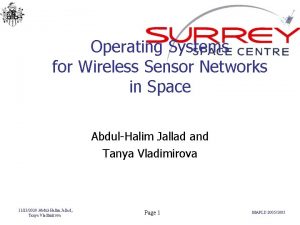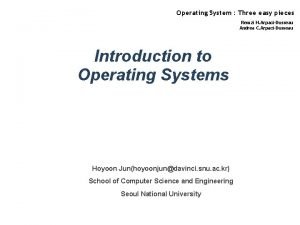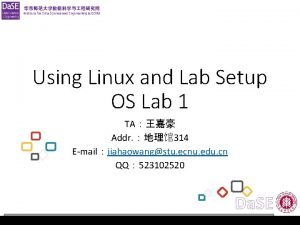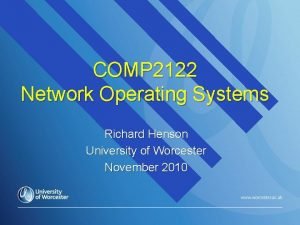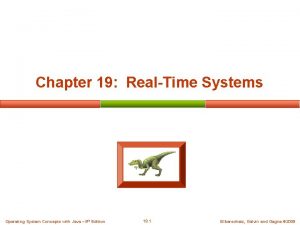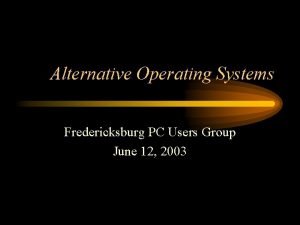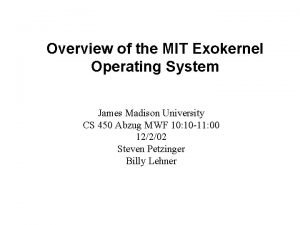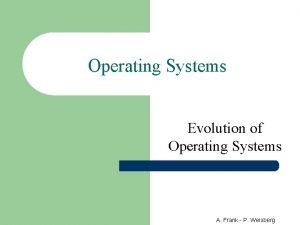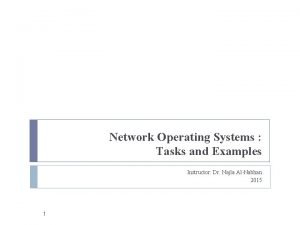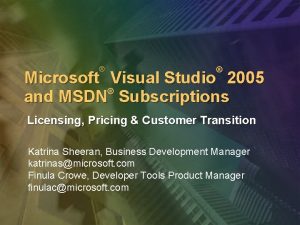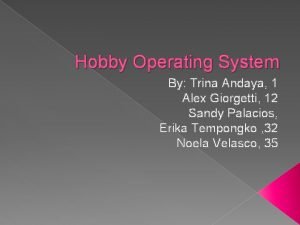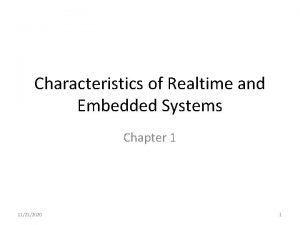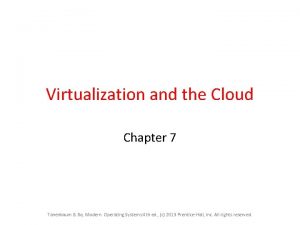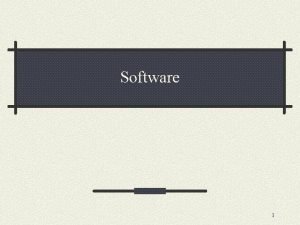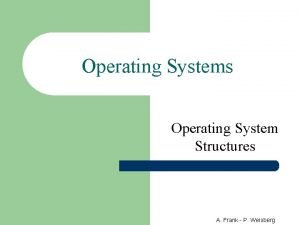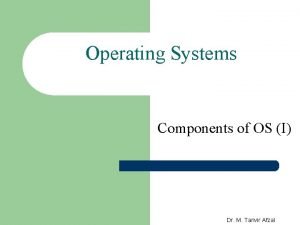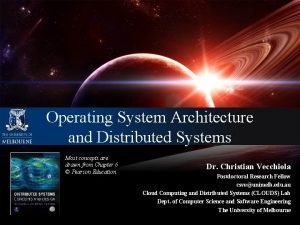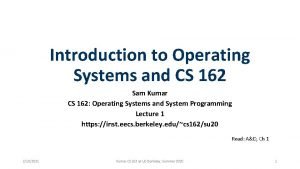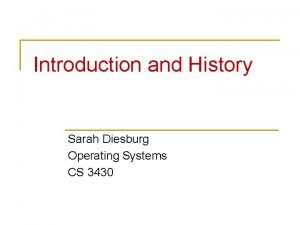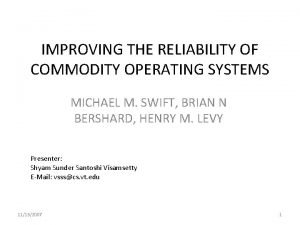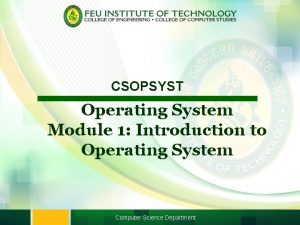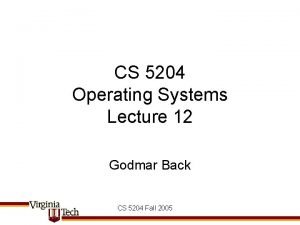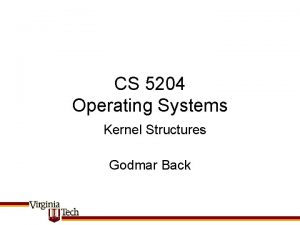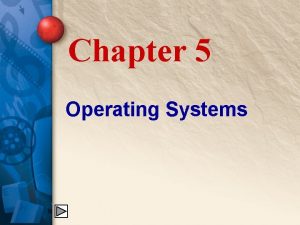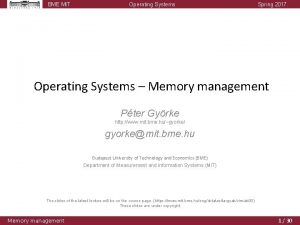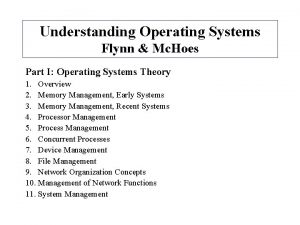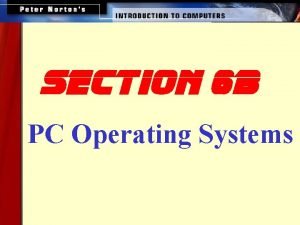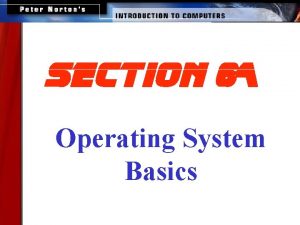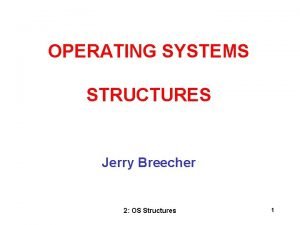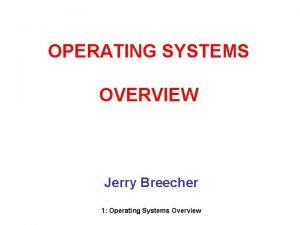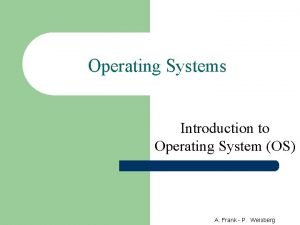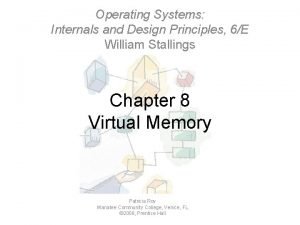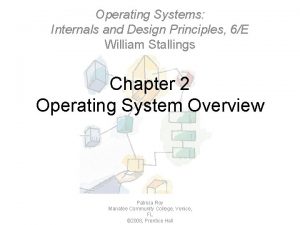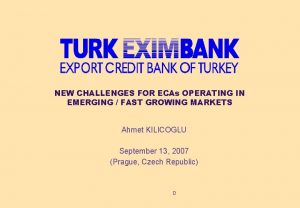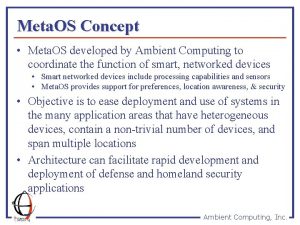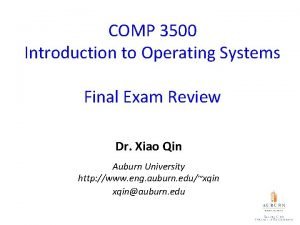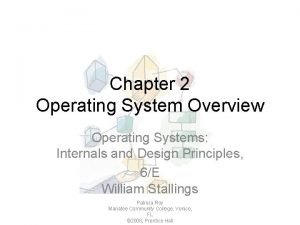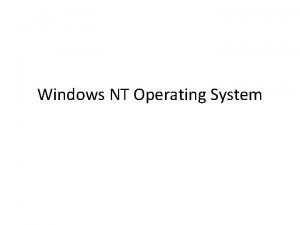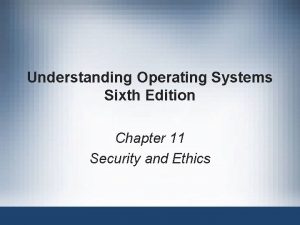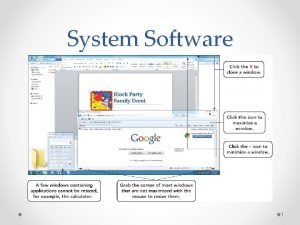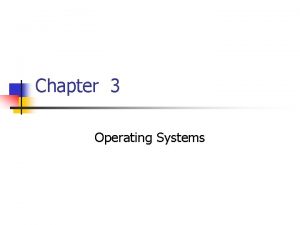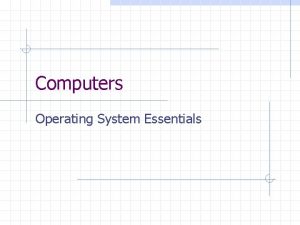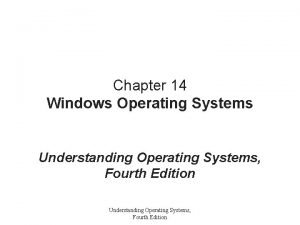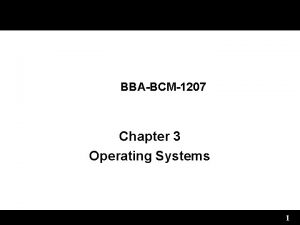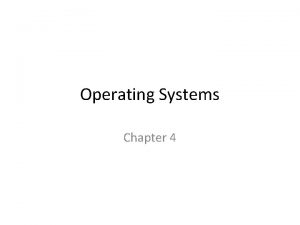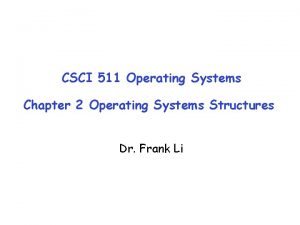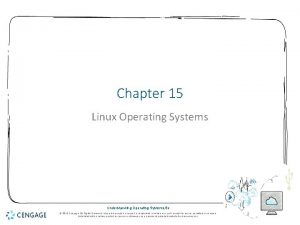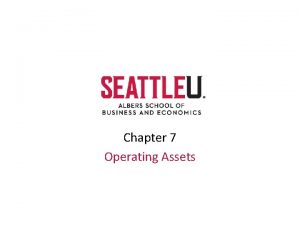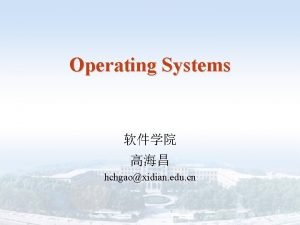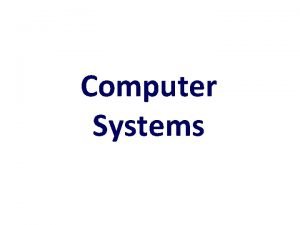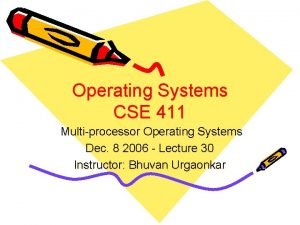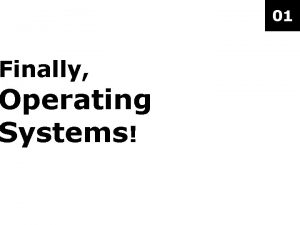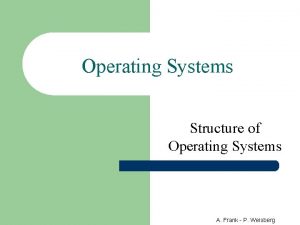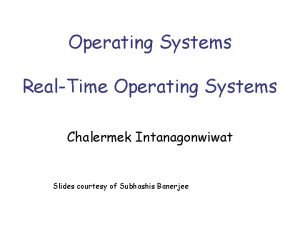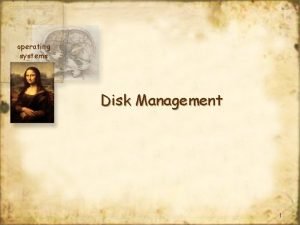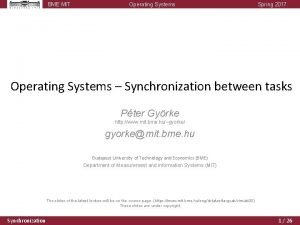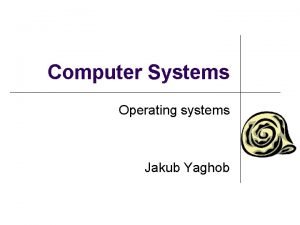Chapter 11 Operating Systems Chapter 11 Operating Systems

























































- Slides: 57

Chapter 11 Operating Systems

Chapter 11 Operating Systems Chapter Outline Operating System Overview Resource Allocation Process Management CPU Allocation Focus – Windows Scheduling Focus – Choosing a Server Operating System Memory Allocation Focus - Intel Pentium Memory Management

Chapter Goals • Describe the functions and layers of an operating system • List the resources allocated by the operating system and describe the complexities of the application process • Explain how an operating system manages processes and threads • Compare and contrast alternative CPU scheduling methods • Explain how the operating system manages memory

Chapter 11 Topics

Operating System Overview • Most important component of system software • Primary purpose: Manage hardware resources and provide support services to users and application programs • Manages CPU, memory, processes, secondary storage (files), I/O devices, and users • Consists of kernel, service layer, and command layer

Operating System Management Functions • Loosely divided between: – Those oriented to hardware resources – Those oriented to users and their programs • Make OS more maintainable: – functions within one layer can be modified without affecting other layers

Operating System Management Functions

Operating System Layers The User’s interface to the Operating System Contains a set of functions executed by application programs and the Command Layer Manages resources and interacts directly with the computer’s hardware

The Kernel Components

Resource Allocation • Single-tasking and multitasking • Goals and tasks • Real and virtual resources

Single-Tasking Resource Allocation • Involves only two executing programs – Application – OS (grants the application all unused hardware resources) • MS-DOS – Most common single-tasking OS – Widely used until early 1990 s

Multitasking Resource Allocation • Norm for modern general-purpose computers • Allows flexibility of application and system software

Resource Allocation Goals • Meet resource needs of each program • Prevent programs from interfering with one another • Efficiently use hardware and other resources

Resource Allocation Tasks • Keep detailed records of available resources; know which resources can satisfy which requests • Schedule resources based on specific allocation policies • Update records to reflect resource commitment and release by programs and users

Real and Virtual Resources • Real resources – Physical devices and associated system software • Virtual resources – Resources that are apparent to a process or user – Meet or exceed real resources by • Rapidly shifting resources unused by one program to other programs that need them • Substituting one type of resource for another

Process Management A process is a unit of executing software managed independently by OS • Requests and receives hardware resources and OS services • Can be stand-alone or part of a group that cooperates to achieve a common purpose • Communicates with other processes executing on the same computer or on other computers

Process Control Data Structures • Process control block (PCB) – Created, updated, and deleted by OS – Used by OS to perform many functions (e. g. , resource allocation, secure resource access, protecting active processes from interference with other active processes) – Normally organized into a larger data structure (called a linked list, process queue, or process list)

Process Control Data Structures • Processes can spawn other processes and communicate with them – Parent process – Child process – Sibling process – Process family

Threads • Portion of a process that can be scheduled and executed independently • Can execute concurrently on a single processor or simultaneously on multiple processors • Share all resources allocated to parent process • Advantage: Reduce OS overhead for resource allocation and process management • Thread control block (TCB) and run queues

CPU Allocation • OS makes rapid decisions about which threads receive CPU control and for how long that control is retained • Threads usually share CPUs (concurrent or interleaved execution)

Concurrent Thread Execution On A Single CPU

Thread States • Ready – Waiting for access to the CPU • Running – Retains control of CPU until the thread or its parent process terminates normally or an interrupt occurs • Blocked – Waiting for some event to occur (completion of service request or correction of an error condition)

Thread States Movement Between States

Interrupt Processing • CPU automatically suspends currently executing thread, pushes current register values onto the stack, and transfers control to OS master interrupt handler • Suspended thread remains on the stack until interrupt processing is completed (blocked state) • Once interrupt has been processed, OS can leave suspended thread in blocked state, move it to ready state, or return it to running state

Scheduling • Decision-making process used by OS to determine which ready thread moves to the running state • Typical methods – Preemptive scheduling – Priority-based scheduling – Real-time scheduling

Preemptive Scheduling • A thread can be removed involuntarily from the running state • Functions of the supervisor (portion of OS that receives control) – Calls appropriate interrupt handler – Transfers control to the scheduler

Preemptive Scheduling • Functions of the scheduler – Updates status of any process or thread affected by last interrupt – Decides which thread to dispatch to the CPU – Updates thread control information and the stack to reflect the scheduling decision – Dispatches selected thread

Processing steps on left occur after Thread 1 makes an I/O service call. Interrupt Processing steps on right occur after I/O device completes I/O operation.

Timer Interrupts • Generated at regular intervals by CPU to give scheduler an opportunity to suspend currently executing thread • Not a “real” interrupt; no interrupt handler to call; supervisor passes control to the scheduler • Important CPU hardware feature for multitasking OSs

Priority-Based Scheduling • Determines which ready thread should be dispatched to the CPU according to: – First come first served (FCFS) – Explicit priority – Shortest time remaining (STR)

Real-Time Scheduling • Guarantees minimum amount of CPU time to a thread if the thread makes an explicit realtime scheduling request when it is created • Guarantees a thread enough resources to complete its function within a specified time • Often used in transaction processing, data acquisition, and automated process control

Windows Scheduling

Windows Scheduling

Windows Scheduling

Windows Scheduling

Memory Allocation • OS allocates memory – When threads are created; responds to requests for additional memory during a thread’s lifetime – To itself and for other needs (buffers and caches) • Memory references are mapped to physical addresses through table lookups and address calculations

Single-Tasking Memory Allocation • Bulk of OS normally occupies lower memory addresses; application program is loaded immediately above it • Contiguous and noncontiguous (fragmented) memory allocation • Address resolution – Process of determining physical memory address that corresponds to memory reference

Single. Tasking Memory Allocation

Single. Tasking Memory Allocation

Multitasking Memory Allocation • The operating system: – Finds free memory regions in which to load new processes and threads – Reclaims memory when processes or threads terminate

Goals of Multitasking Memory Allocation • Allow as many active processes as possible • Respond quickly to changing memory demands of processes • Prevent unauthorized changes to a process’s memory region(s) • Implement memory allocation and addressing as efficiently as possible

Multitasking Memory Allocation Memory is divided into fixed-sized partitions.

Multitasking Memory Allocation Processes are allocated memory partitions to store instructions and data.

Multitasking Memory Allocation The Operating System maintains tables to track partition allocations and free space.

Memory Fragmentation • As memory becomes more fragmented, larger processes have increasing difficulty finding enough contiguous partitions • To address the problem: – Compaction (large overhead) – Noncontiguous memory allocation

Memory Partition Allocation And De-allocation leads to an increasing number of small free partitions separated by allocated partitions.

Contiguous Memory Allocation A new process requiring 4 MB of memory can’t be loaded unless memory is first compacted.

Noncontiguous Memory Allocation • Portions of a process can be allocated to free partitions anywhere in memory • Uses small fixed-sized partitions • More flexible than contiguous memory allocation, but requires more complex partition tables and address calculations

Noncontiguous Memory Allocation A new process requiring 4 MB of memory can be divided and loaded into the four free partitions.

Virtual Memory Management • Allocates portions of processes (pages) to small memory partitions (page frames) • Swaps pages between memory and secondary storage as needed • Page hits, page faults, page tables • Page files and victims

Process Page Table

Memory Protection • Prevents errors in one program from generating errors in another • Adds overhead to each write operation

Memory Management Hardware • Complex memory management procedures incur substantial overhead • Modern CPUs incorporate advanced memory allocation and address resolution functions in hardware (e. g. , Intel Pentium)

Intel Pentium Memory Management The Pentium uses six registers to hold data structures called segment descriptors. Each register stores: • the physical memory address of the first byte of the segment • the size of the segment (1 byte to 4 GB) • the segment type • access restrictions – read-write (RW) – read-only (RO) – execute-only (EO) – execute-read(ER) • privilege level – 0 through 3; 0 indicates most privileged

Intel Pentium Memory Management

Summary Operating system overview Resource allocation Process management CPU allocation Memory allocation

Chapter Goals • Describe the functions and layers of an operating system • List the resources allocated by the operating system and describe the complexities of the application process • Explain how an operating system manages processes and threads • Compare and contrast alternative CPU scheduling methods • Explain how the operating system manages memory
 Some example of operating system
Some example of operating system Evolution of operating systems
Evolution of operating systems Components of an operating system
Components of an operating system Component of operating systems
Component of operating systems Wsn operating systems
Wsn operating systems Os three easy pieces
Os three easy pieces Operating systems lab
Operating systems lab Open source operating system
Open source operating system What is modern operating system
What is modern operating system File management components
File management components Design issues in distributed systems
Design issues in distributed systems Early operating systems
Early operating systems Real-time operating systems
Real-time operating systems Can we make operating systems reliable and secure
Can we make operating systems reliable and secure Alternative operating systems
Alternative operating systems Exo kernel
Exo kernel Operating systems: internals and design principles
Operating systems: internals and design principles Operating system evolution
Operating system evolution Examples of network operating systems
Examples of network operating systems Visual studio 2005 team suite
Visual studio 2005 team suite Menuet os
Menuet os Real time operating system characteristics
Real time operating system characteristics Operating systems concepts
Operating systems concepts Understanding operating system
Understanding operating system Layers of operating system
Layers of operating system Software is divided into how many parts
Software is divided into how many parts Operating system structure
Operating system structure Components of os
Components of os Architecture of distributed operating system
Architecture of distributed operating system Module 4 operating systems and file management
Module 4 operating systems and file management Modern operating systems 3rd edition
Modern operating systems 3rd edition Cs162 summer 2021
Cs162 summer 2021 Operating systems
Operating systems Improving the reliability of commodity operating systems
Improving the reliability of commodity operating systems Overview of operating systems
Overview of operating systems Operating systems
Operating systems Operating systems structure
Operating systems structure Structured computer organization
Structured computer organization 5 operating system
5 operating system Mit operating systems
Mit operating systems Operating system lecture notes
Operating system lecture notes Types of operating systems
Types of operating systems Section 6 operating systems
Section 6 operating systems Section 6 operating systems
Section 6 operating systems Operating system
Operating system Operating system overview
Operating system overview Operating systems: internals and design principles
Operating systems: internals and design principles Operating systems: internals and design principles
Operating systems: internals and design principles Operating systems: internals and design principles
Operating systems: internals and design principles Challenges of emerging trends in operating systems
Challenges of emerging trends in operating systems Meta os
Meta os Types of operating systems
Types of operating systems Operating systems final exam
Operating systems final exam Operating systems: internals and design principles
Operating systems: internals and design principles Features of windows nt operating system
Features of windows nt operating system Operating systems
Operating systems Stand alone operating system
Stand alone operating system Real time operating system concepts
Real time operating system concepts




